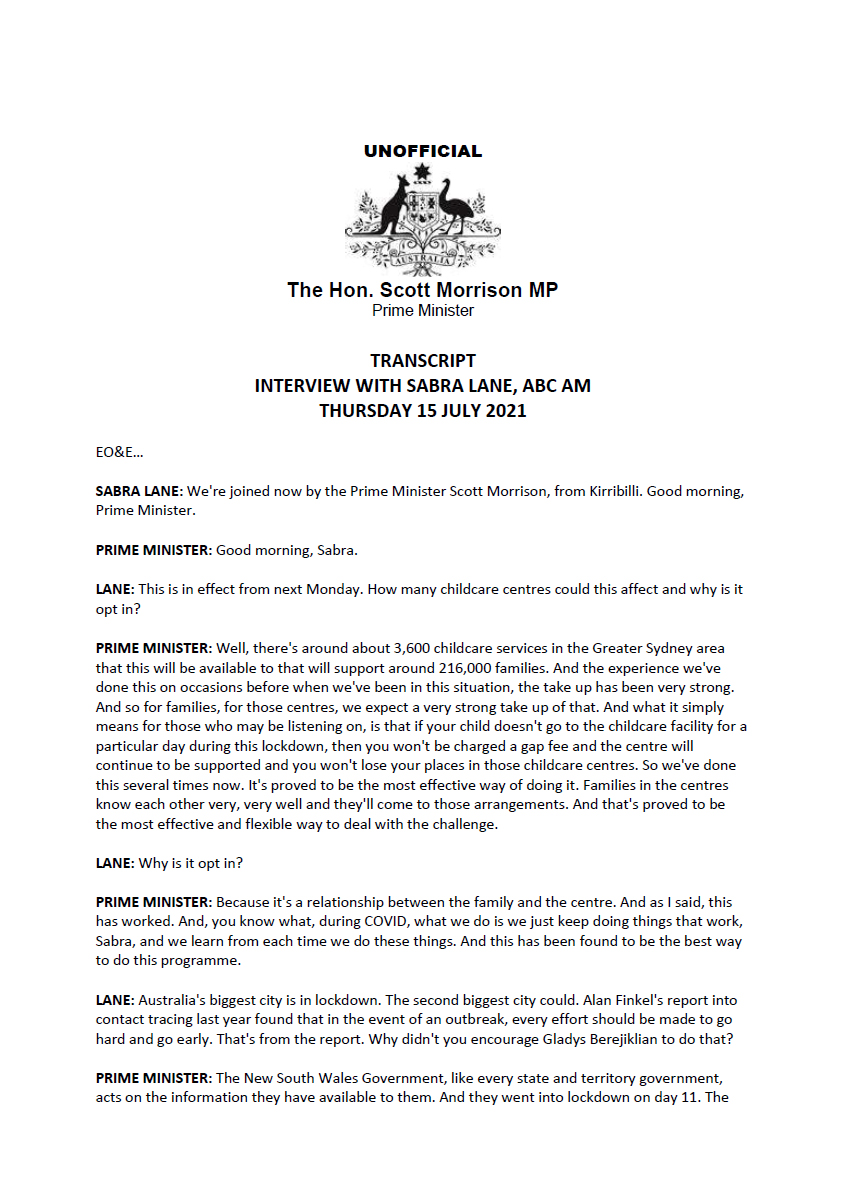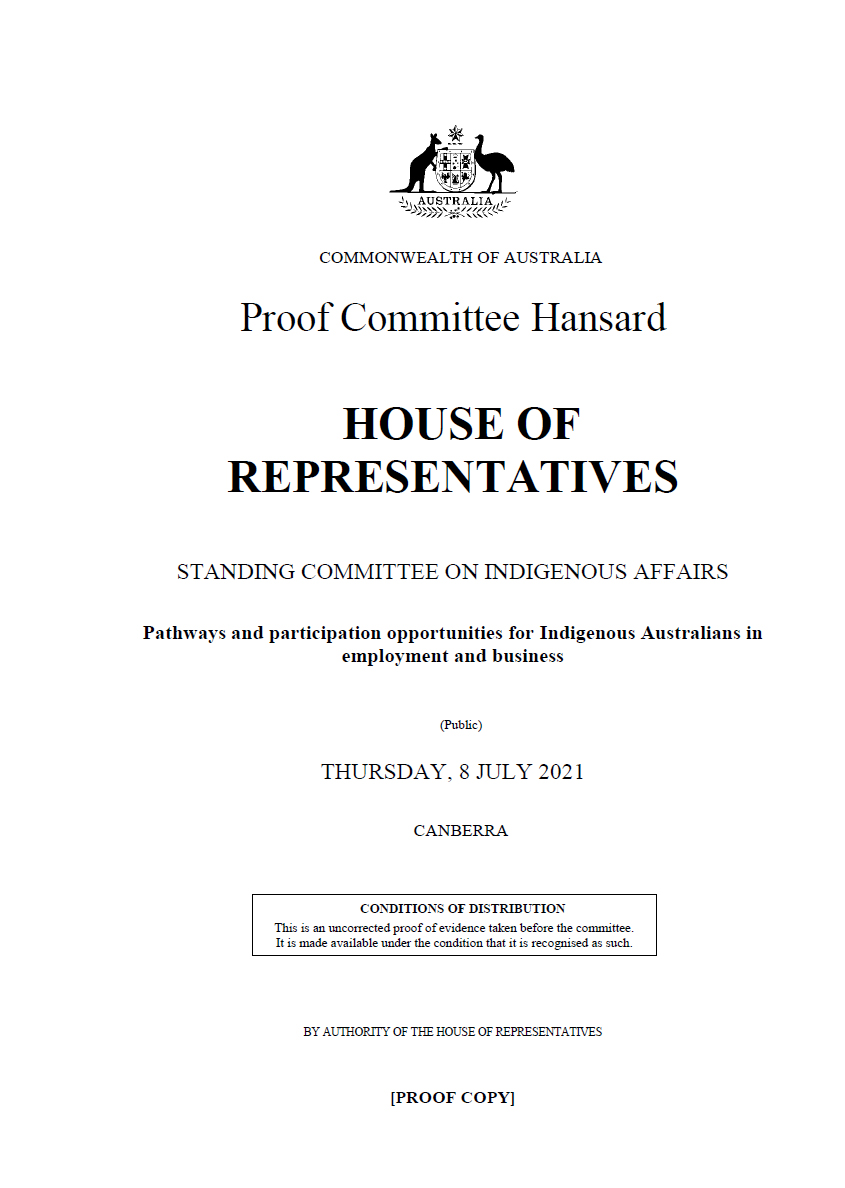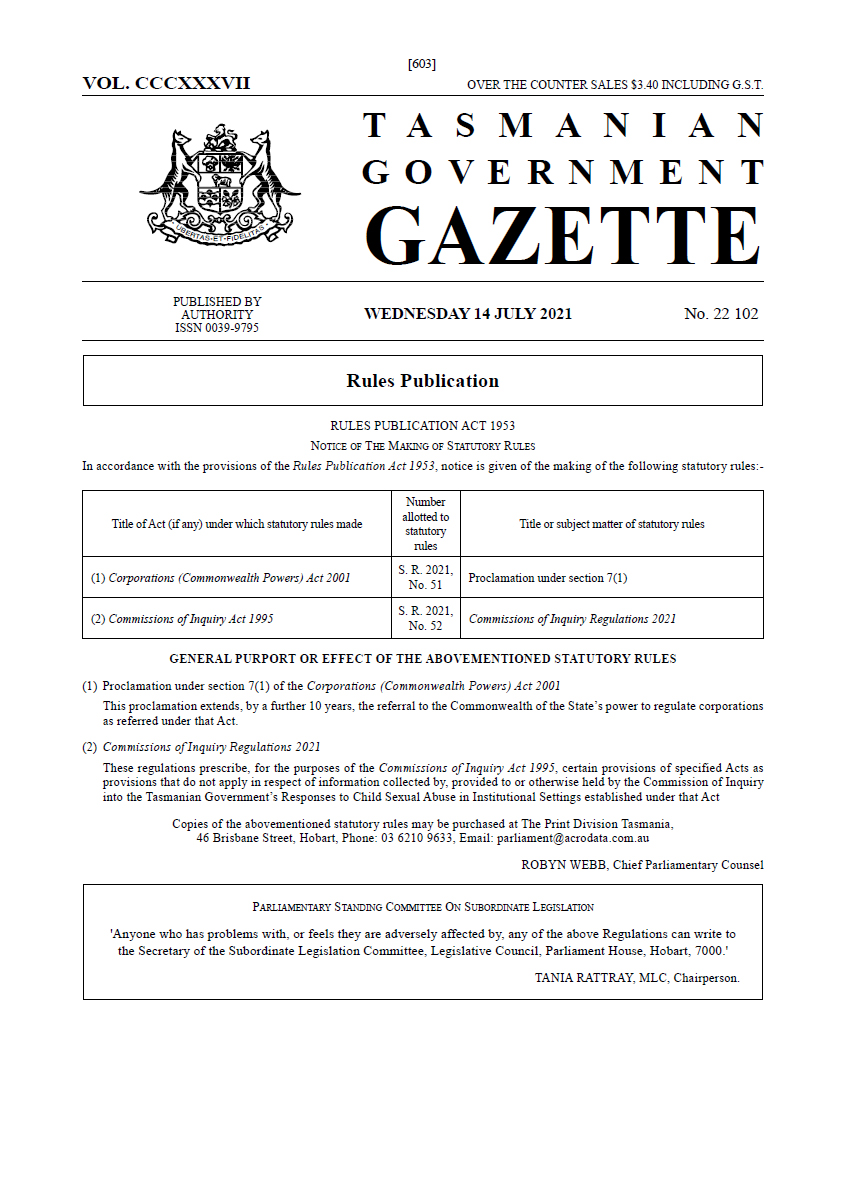
|
 AUGUST 2021 AUGUST 2021
|
Books
Q & A with Farid Assaf
Assaf’s Winding Up in Insolvency 3rd edition (earlier known as Statutory Demands and Winding Up in Insolvency) is an essential practical reference text providing comprehensive treatment of all aspects of winding up in insolvency. We took the opportunity to ask Farid Assaf SC of Banco Chambers a few questions about the text.
Q: Why the new title?
The new work is about all aspects of winding up in insolvency. To reflect the change in emphasis, I have added two new chapters. The first new chapter contains a comprehensive guide to practitioners as to how to establish insolvency by way of the various presumptions of insolvency as well as how to establish actual insolvency. The other new chapter discusses cross-border aspects of winding up as well as the winding up of Part 5.7 bodies which are increasingly being sought to be wound up under the Corporations Act.
Q: You discuss the impact of new legislation in the new work. In your view, what are the most significant reforms made by the Corporations Amendment (Corporate Insolvency Reforms) Act 2020?
At a general level, the most significant reform is the attempted introduction by Parliament of a debtor-in-possession model of insolvency and restructuring. In many respects the reform from that perspective is quite revolutionary and stands in stark contrast to the traditionally creditor-friendly philosophy underlying Chapter 5 generally. The debtor-in-possession model is based upon Chapter 11 of the United States Bankruptcy Code which is probably the most pro-debtor piece of insolvency legislation in the world. Interestingly, other traditional creditor-friendly jurisdictions, such as the United Kingdom and Singapore, have also sought to introduce aspects of the debtor-in-possession model. Singapore in particular recently introduced quite drastic and I must say, very impressive, legislation with a view to seeking to establish itself as a restructuring hub in Asia. I, personally, would have liked to have seen similar legislation enacted in Australia.
Q: What will be the most enduring impact of the Covid-19 pandemic on Winding Up?
From the perspective of winding up, I suspect an expansion of the kinds of matters a Court will take into account when exercising its discretion whether or not to make a winding up order. There are already a few cases where one can see the Court being mindful of the severe impact the pandemic has had on companies, especially smaller ones.
Q: Justice Black of the Supreme Court of NSW notes in his foreword many occasions on which the earlier editions have been cited by Courts. Do you remember the first case it was cited in?
Yes, a July 2009 decision of Justice White of the Supreme Court of New South Wales (now of the New South Wales Court of Appeal) in Aerospace Aviation v Deshmukh and Ors [2009] NSWSC 659.
Q: You have included some terrific precedents and checklists - do you have any specific drafting tips for this area of law?
Yes, buy the book! Seriously though, if I had one tip it would be to read the legislation, including any prescribed forms, very carefully to ensure that the drafter takes into account and addresses all relevant matters.
Q: You reviewed hundreds (thousands?) of cases for this new edition? What cases do you think are most critical/pivotal in terms of recent developments in winding up law in Australia
Almost any decision of Justice Black of the Supreme Court of New South Wales in the past ten years. His Honour has addressed almost a myriad number of issues relating to winding up in the substantial body of case law he has single-handedly produced over the years.
Q: In 10 words or less explain why practitioners should buy the new book?
That’s easy – it saves you time, angst and money.
ABOUT THE AUTHOR
Farid Assaf SC is a barrister at Banco Chambers, Sydney. He was admitted as a solicitor in 1998 while employed as a lawyer with the then Australian Securities Commission and commenced at the Bar in 2000. Farid has a diverse national practice with a particular emphasis on corporations and insolvency law matters and is ranked in Chambers and Partners Australia Directory, Best Lawyers and Doyle’s Guide. Farid is also a Fellow of INSOL International and the author of a number of leading texts in insolvency law all published by LexisNexis.
Capital Monitor™
Rules of Engagement: Monitoring Government News, Information & Legislation is Critical Capital Monitor
Public figures and their scandals, disasters, tragedies, and most recently a global pandemic tend to make the headlines in the media daily. Gone are the days where you could hope to find most of the information you need on a more serious matter in the so called “broadsheet newspapers”. Driven heavily by personalities, click bate advertising, and political alignment, today’s media, further fragmented by the ubiquitous social media, can offer incomplete, if not sketchy coverage at best.
While enacted legislation may receive some coverage - subject to controversy - proposed legislation, such as Bills going through the legislative-making machine of Parliament, hardly sees the light of day unless it involves significant shift in public policy. Yet it can have a significant impact on business.
Furthermore, the debate around it, or the historical context that includes the perspective of the Government, Opposition, Minor Parties/Independents, as well as industry, or academia is often difficult to capture in a single news story, even from a broadsheet.
Even through the thick of Covid-19 in 2020, when Parliaments nation-wide rose indefinitely, easily operating for less than half of the year, legislative activity hardly slowed. The new Acts and Regulations tally sits in the several-hundred for the state and territories, and in the thousands for federal parliament each year.
In 2021, staying across everything has become harder than ever, with audiences hungrier than ever for reliable, official, and accurate information. Media monitoring can paint a picture, but does it cover the detail that may impact business’ bottom line sufficiently, while full text searching on government websites may yield a significant number of irrelevant hits, particularly if the information is deliberately “buried”. In Australia the process is further complicated by the reality of numerous jurisdictions, all with variations and quirks in terminology, as well as bureaucratic process.
When organisations have the right news & information that allows them to monitor legislative activity and the debate around it in real time, their capacity to affect the legislative process, prepare for impending costs and other changes, or advise their clients in a timely manner grows exponentially. New legislation after all can also result in endless business opportunities.
For 30 years, Capital Monitor has alerted subscribers from all walks of life to parliamentary, government, legislative, regulatory, and judicial news, and information as it happens, to help subscribers quickly identify, assess, and respond to legislative activity.
An information session, run by Capital Monitor in the coming weeks, will offer varying perspectives from professionals who need to stay on top of government news & information in the age of digital politics and activism. This will include a panel discussion, and a detailed overview and demonstration of the platform and content included. Critical for business operating in highly regulated industries, Capital Monitor often helps subscribers anticipate legislative and regulatory change before it's a done deal, so they can react, respond to, or influence a policy outcome in real time, and lobby government or business for the right outcomes.
Lexis Advance®
Halsbury’s® Laws of Australia
We have recently published the following updates.
Dr Pornsakol LLB (Hons I, University Medal), (Chulalongkorn), LLM (Hons) (Cambridge), LLM (Sydney), SJD (UNSW) Teaching Fellow of University of New South Wales, has updated the entire Product Liability Title. This update includes new statements of law and supporting authority on various topics including:
- Defendant’s Duty of Care
- Loss or Damage
- Causation
- Liability for Unacceptable Quality
- Meaning of ‘Goods’
- Liability for non-correspondence of a product with a description
- Claims under the Australian Consumer Law (See Australian Competition and Consumer Commission v Woolworths Ltd [2016] FCA 44; BC201600666: Where the person knowns that there is a safety issue that has the potential to cause injury, there is reasonable expectations that the supplier or manufacturer will either stop supplying or manufacturing the goods or will at least warn customers of the safety issues.
Oliver Berkmann LLB BEc MEc; Barrister, 6 St James Chambers has updated Superannuation Guidecard II (Retirement Savings Accounts) and IV (Superannuation Guarantee Charge). This update includes new statements of law and supporting authority on various topics including:
- Amnesty from liability to pay additional superannuation guarantee charge
- Assessment of additional superannuation guarantee charge
- Duties of Retirement Savings Account Providers
- Court power of Disqualification
- Obligations of Australian Financial Services licencees
- Acceptance of contributions
Andrew Norris (BA)(UNIMELB) (JD)(UNIMELB); Barrister, William Crockett Chambers has updated Criminal Law Guidecard VIII Sentencing. This update includes new statements of law and supporting authority on various topics including:
- Character
- Role of the Prosecution
- Children
- Habitual and dangerous offenders
Paragraph Citations in Unreported Judgments
Building on the successful release of the Paragraph Filter and ‘Paragraphs Citing’ Tab in CaseBase, LexisNexis is now introducing a suite of Paragraph Citations features in Unreported Judgments. These new features will be available to customers in August 2021.
The Most Cited Paragraphs Pod
The Most Cited Paragraphs Pod is displayed under the ‘About this Document’ pod on the right-hand side of full text cases in the Unreported Judgments publication.
The pod shows the ten paragraphs in the judgment that have been most frequently discussed in subsequent decisions. Selecting one of the horizontal bars will take you to the text of the corresponding paragraph, so you can jump straight to the most influential passages.
For a data visualisation of the distribution of citations across the whole case, users can click on the ‘See details in CaseBase’ link at the top of the pod to go to the Paragraph Filter.
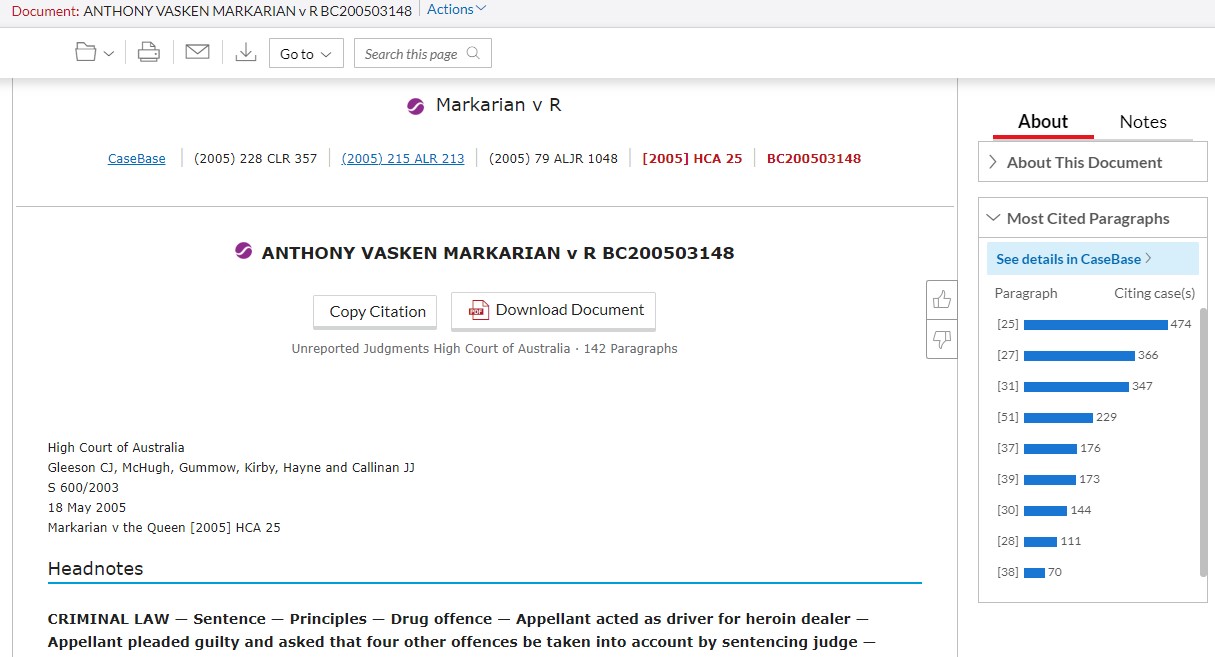
Figure 1 The Most Cited Paragraphs Pod appears on the right hand side of Unreported Judgments.
Paragraph Citation Indicators
Paragraph Citation Indicators appear on the left-hand side of the full text of Unreported Judgments, beside the paragraph numbers. They display the number of cases that have subsequently cited that paragraph. If no cases have specifically cited a given paragraph, no indicator will appear in the margin.
As you read the case, the indicators provide insight on the relative importance of arguments discussed. When the citation count is high, it suggests researchers should pay close attention to how the arguments have been applied, evolved, qualified or disputed over time. Where a passage has not received specific attention, researchers should refer to the cases that have cited the whole judgment by looking in the ‘Cases referring to this case’ table in CaseBase.
The indicators are clickable. When clicked, they open a pop-up containing the text of citing paragraphs.
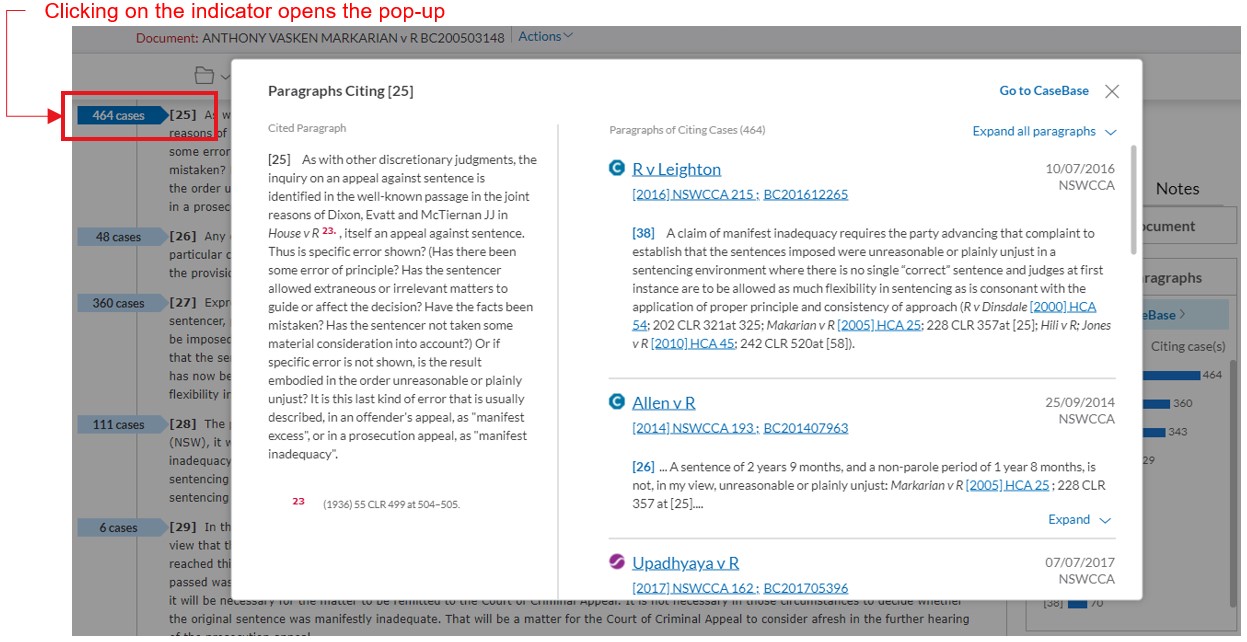
Figure 2 Clicking on the Citation Indicators on the left opens the pop-up showing the text of citing paragraphs in subsequent decisions.
Citing Paragraphs Pop Up
The Citing Paragraphs Pop-up appears after you click on any Citation Indicator. This pop-up shows the text of the selected cited paragraph on the left, with the text of citing paragraphs from subsequent cases on the right.
The side-by-side view gives you the ability to assess the discussion of arguments and gauge the usefulness of a citing case.
Links to CaseBase are provided for convenient access to additional tools for more in-depth analysis, such as the Paragraph Filter and the ‘Narrow by’ search.
Click here for a list of webinars designed to keep you up to date on our Products.
Unreported Judgments: Civil and Administrative Tribunal is now available
The decisions of the Civil and Administrative Tribunal in each State are being centralised into one handy reference.
The catalogue starts with:
- Queensland - QCAT and QCATA (Appeal);
- Northern Territory – NTCAT, and
- NSW – NCAT
For these jurisdictions the backset of all available full-text judgments since the Civil and Administrative Tribunal commenced are included. New judgments will be added as they are handed down.
Further states are planned as Unreported Judgments: Civil and Administrative Tribunal grows.
Going forward, customers who currently access the NCAT decisions will need to add Unreported Judgments: Civil and Administrative Tribunal to their Lexis Advance package. To aid this transition, NCAT decisions will remain temporarily available in Unreported Judgments.
Please contact your Relationship Manager for more information.
LexisNexis Legal Talk Series

Introducing the LexisNexis Legal Talk series where we will bring developments in practice areas, insights and news.
Listen to our latest features;
| Expert Evidence. Isn’t there a better way? | |
| Sydney Jacobs Barrister of 13 Wentworth Chambers & Julia Park Product Adoption Specialist of LexisNexis |
LISTEN |
| Casuals: Convert or not to convert... That’s the question | |
| Yoness Blackmore Senior Legal Writer Practical Guidance & Julia Park Product Adoption Specialist of LexisNexis |
LISTEN |
LexisNexis Practical Guidance
Practical Guidance is so much more than a gateway to deeper LexisNexis research. Written by our specialist practitioners and legal writers, Practical Guidance is a powerful workflow tool. Take a look at our latest enhancements.
New Practical Guidance practice area homepage
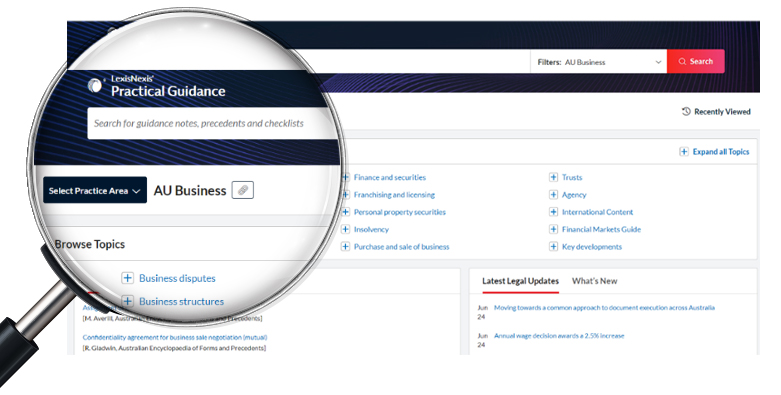
- Enjoy easier navigation to key content within a practice area, such as guidance notes, precedents, checklists and tools
- New user experience to sharpen your skills within Practical Guidance
New subtopic table of contents browse menu
- Browse through a topic with ease and without backtracking to the practice area homepage
- Easily change topic to continue moving through key research within a practice area module
New module – Practical Guidance Dispute Resolution
- This new module covers informal and formal mechanisms of dispute resolution, including aspects of ADR and litigation practice across Australian federal, state and territory courts and tribunals.
New Practical Guidance Signing Tool
- Step by step signing tool allowing users to create execution blocks they need to ensure a valid contract.
- Currently available with: Banking & Finance, Business, Corporations and Mergers & Acquisitions modules with more to come
New Practical Guidance Employment guide and comparative table
- A quick reference guide on how to navigate material with ease
- A new comparative table which easily identifies the rights and obligations of employees and independent contractors.
New Practical Guidance Employment – Casual employment and casual conversion suite of documents
A new workflow has been published to support the engagement of statutory casual employees, compliance with new casual conversion obligations in the National Employment Standards and the implementation of appropriate measures to enable a court to make offsetting orders against casual loadings paid to misclassified casual employees.
The workflow includes a revised casual employment Guidance Note, a new casual conversion Guidance Note, new casual employment information statement Guidance Note, revised casual employment letter agreement, letter correspondence for casual conversion offers and requests and two Checklists scaffolding processes for casual conversion offers and requests. This workflow features in the Employment Frequent Tasks Tool.
Practice Area Round-Ups
The latest news and developments in your practice area, delivered directly to your inbox. The fortnightly Practice-Area Round-Ups are available as part of your subscription to Practical Guidance.
A new General Counsel Round-Up was launched in July 2021. Round-Ups are also available for: Banking & Finance; Business; Competition; Consumer; Corporations; Cybersecurity, Data Protection & Privacy; Dispute Resolution; Employment; Insolvency & Restructuring; Intellectual Property; Mergers & Acquisitions; and Property.
Coming soon – new precedents in Practical Guidance Banking & Finance
Supplement your firm’s precedent bank with the following new precedents to be launched in 2021: CHESS sponsor tripartite deed, Intragroup facility agreement, Director’s guarantee, Process agent letter, Section 64 notice and others. Our precedents reflect market best practice for efficient drafting or to sanity check your firm’s documents against.
Coming soon – A quick guide to directors’ duties in Practical Guidance Corporations
A concise, overview of general directors’ duties under the Corporations Act, consequences of breaching duties, who can take action for breach, and how to protect directors from liability. This quick guide sets out the key issues at a glance, and would be a useful addition to a briefing pack for a new director or as part of a director’s ongoing professional development program.
Coming soon – New Bankruptcy Topic in Practical Guidance Insolvency & Restructuring
The Insolvency & Restructuring module will be adding a new Topic on Bankruptcy. This will provide guidance and checklists for practitioners acting for creditors or debtors in the bankruptcy process from bankruptcy notices through to orders for sequestration as well as guidance for the period a debtor is in bankruptcy and personal insolvency agreements. New bankruptcy precedents will also be added.
Coming soon – Signing Tool in Practical Guidance Property
We will soon be launching a signing tool customized for property law practitioners. This is an easy to use signing tool that will help property lawyers produce the correct signing blocks for their agreements or deeds and includes practical “tool tips” on signing formalities.
Coming soon – New Indigenous Culture Topic in Practical Guidance Intellectual Property
A new Topic on focussing on Indigenous Culture and IP will be added to the Intellectual Property module this year.
New Mergers Case Tracker for Practical Guidance Competition
A new Mergers Case Tracker is planned for delivery in the second half of 2021, summarising recent mergers and acquisitions (M&A) notified to the Australian Competition and Consumer Commission (ACCC). This will save practitioners valuable research time enabling them to advise clients on prospects of proposed mergers and acquisitions. The Case Tracker will allow lawyers to quickly and easily identify information on mergers and acquisitions notified to the ACCC including:
- mergers that went to 'Statement of Issues’ (Phase 1) stage;
- the timeframe it took for the ACCC to consider each transaction and to conduct market inquiries (if at all); and
- relevant market definition and potential competition law issues associated with M&A activity across various industries.
Practice area highlights
- PG Banking & Finance – Updated Frequent Tasks Tool to help practitioners quickly identify the relevant resources to assist them in their day to day workflow. Regular updates to our Electronic Signing and LIBOR Transition topics to keep practitioners informed on the latest developments in these areas.
- PG Business – The precedent Shareholders’ agreement (short form) has been refreshed and enhanced. This precedent sets out the basic terms and conditions a practitioner would expect to find in a shareholders’ agreement.
- PG Competition – A new Competition Mergers Case Tracker is planned for delivery in the second half of 2021, summarising recent mergers and acquisitions notified to the ACCC. This will save practitioners valuable research time enabling them to advise clients on prospects of proposed M&A activity. New Guidance Notes and Checklists covering joint ventures, dual listed company arrangements and most favoured nations (MFN) clauses to assist practitioners’ understanding of the risks associated with various corporate structures.
- PG Consumer – Enhanced guidance on product safety and the consumer guarantee regime. Updated tool: Application of the Term “Consumer” and related terms in the Australian Consumer Law that helps practitioners to quickly ascertain when their clients fall into key consumer law definitions.
- PG Corporations – Member meetings guidance updated to reflect COVID-19 developments (including AGMs). Guidance on financial reporting and share reductions/buy-backs overhauled to set out practice tips and follow lawyers’ workflow. COVID-19 toolkit for corporations law and ASIC forms tool continually updated to highlight current resources for frequent tasks. Financial services guidance and checklists are being updated to reflect recent Corporations Act amendments arising out of the Hayne Royal Commission.
- PG Cybersecurity, Data Protection & Privacy – New Infographics on Privacy and Data Protection. Updates to guidance on cross-border transfers of personal data to reflect international developments, including Brexit, the new draft Personal Information Protection Law in China, and amendments to the Personal Data Protection Act 2012 in Singapore and NZ Privacy Act.
- PG Dispute Resolution – New Subtopic on trials in the Queensland Supreme Court, including new checklist for readiness and preparation for trial, and new precedent for objections to written evidence. New guidance on security for costs and notices to produce documents raised in pleadings and affidavits.
- PG Employment – New comparative table on rights and obligations of employees and contractors. Numerous new Guidance Notes including notes on effective management of risks in the recruitment process, and casual employment information statements. New precedent templates for flexible working policy and related letters. Updated Guidance Notes on the content of modern awards, approval of enterprise agreements, and good faith bargaining. New and updated workflow and content on casual employees in light of recent statutory changes, including two new checklists on casual conversion and casual employment, and eight new precedents.
- PG General Counsel – New checklist on essential elements of a whistleblower policy. Practice Area Round-up launched in July 2021.
- PG Governance – New checklist on whistleblower workflow. Updated guidance on whistleblower policies. New international Subtopic on ESG and impact investing.
- PG Insolvency & Restructuring – The Winding Up Tool, Checklists and Guidance Notes have been updated to reflect the increased minimum amount for statutory demands. Guidance for calculating preference claims has been updated to reflect case law ending the peak indebtedness rule. The coverage of Liquidation of trustee companies has been expanded to provide broader coverage and new practice tips for practitioners acting for liquidators of trustee companies.
- PG Intellectual Property – Added guidance on unregistered trade marks and standing to bring proceedings, enhanced guidance on evidence in trade mark proceedings. Coming up – a new Topic on Indigenous Culture and IP will be added to the module.
- PG Mergers & Acquisitions – Updated guidance on public M&A takeover transactions (including new guidance on hostile takeovers) and competition issues for all M&A transactions. New international guidance on private equity fund formation and transactions. Overhauled Transitional Services Agreement precedent for market best practice and improved drafting. New Topic on secondary fundraising, providing guidance for ASX-listed companies raising capital, to be published by end Q4 and will be particularly relevant for large law/corporate practitioners.
- PG Property – Guidance across all Topics of the Property Module has been updated in light of recent changes to law and practice. One key highlight is the overhaul of all Guidance Notes in the Residential Tenancies (Victoria) Topic to reflect wholesale changes in the law. Precedents, checklists and toolkits in the Sales and purchases, Retail leases, Commercial leases, Residential tenancies, Taxation and revenue, Mortgages, Options, Title to land, Contracts – general principles and Encumbrances Topics have been updated to align with ongoing changes to the law, including those impacted by COVID-19.
MLex
Confidently Navigate and Respond to Regulatory Risk
Stay ahead of key regulatory issues with expert insight, commentary and analysis to ensure you are well positioned to take advantage of opportunities posed by regulatory change as well as mitigate the risks. With a track record of uncovering regulatory risk before it breaks in other news outlets, MLex provides up-to-the-minute coverage of regulatory threats and opportunities from the perspectives of M&A, antitrust & competition, trade, & digital privacy & security, as well as sector-specific regulation across TMT, energy and financial services.
MLex is on the cutting edge of reporting on global regulations, both in effect and proposed. We have local contributors based in Melbourne and Sydney and others covering 12 other jurisdictions around the world. Our exclusive, real-time coverage of probes, enforcement trends, litigation and regulator commentary help ensure you are informed and able to respond immediately to client risks and opportunities.
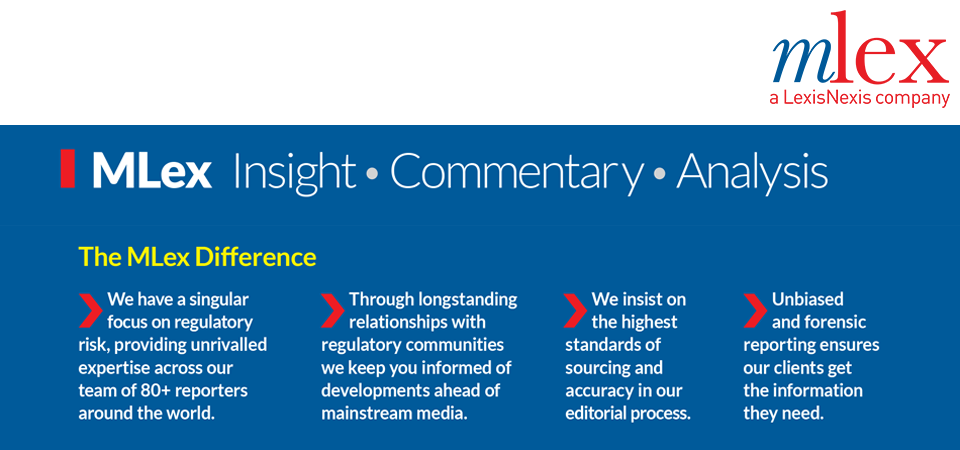
Our Global Presence
Our journalists cover the world from 14 bureaux in key jurisdictions:
EUROPE: Brussels • London
AMERICAS: Washington • New York • San Francisco • São Paulo
ASIA-PACIFIC: Hong Kong • Beijing • Shanghai • Seoul • Tokyo • Jakarta • Melbourne • Sydney
For more information about MLex, please reach out to your Relationship Manager.
Nexis
Launch of Nexis Readers and Newsletters
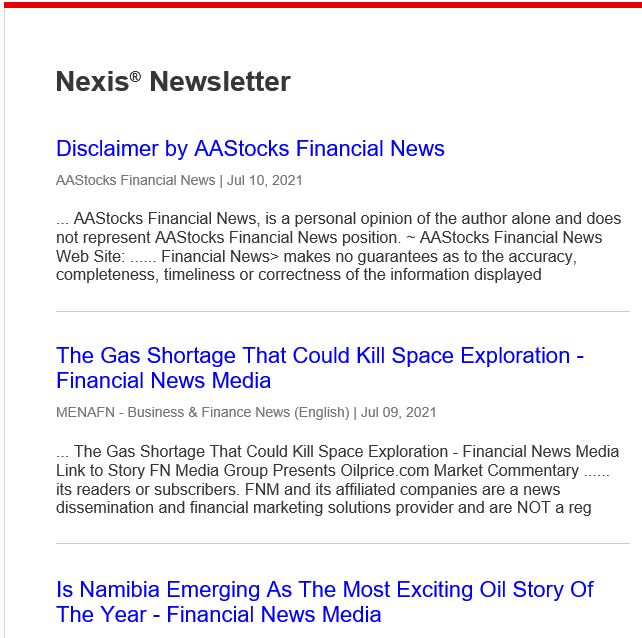
Figure 1- A representative example of a Newsletter
Nexis® aggregates information from over 36,000 international news and business sources, as well as thousands of business-relevant websites, blogs, and forums. Tens of thousands of sources and millions of full text documents are at your disposal to research virtually any business topic.
Nexis® has recently launched Nexis Readers roles and Newsletters to gather and share news content with others in your organization. This enhancement will help you streamline communication, improve collaboration, and accelerate decision making.
All Nexis User roles can now create Newsletters in which they will be able to share selected articles from search results, add notes, preview and customize templates used for the Newsletters. These Newsletters can be set to run periodically and can be distributed to email recipients that are Nexis users and readers.
Nexis Newsletters are now available within the Search results tab for all Nexis Users roles at no additional cost.
Nexis Readers is a new role being introduced in Nexis. Reader roles and credentials can be assigned to people within the same organization as the Nexis User.
Nexis Readers will have access to a lighter version of Nexis with read-only capabilities including:
- A simplified Nexis Home Page with pods that focus on items shared with the Reader (e.g. Alerts, Recently Viewed Documents, Newsletters); and
- Folders providing access to content shared with the Reader (e.g. shared documents, shared saved searches).
Readers cannot create searches, but they can run saved searches that have been shared with them. They will be able to deliver documents and results lists (e.g. download, email, print, send to cloud).
Readers can be added to existing Nexis subscriptions at an additional charge.
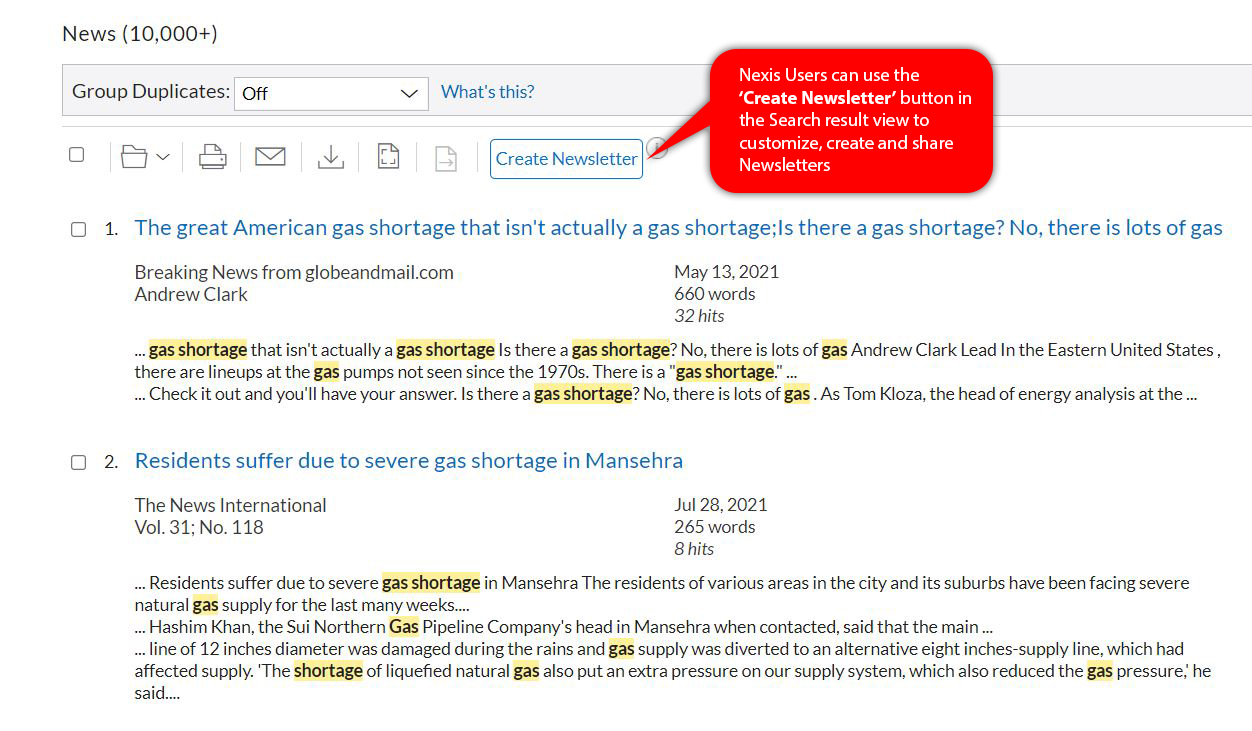
Figure 2- Nexis Newsletters- All Nexis User roles can create Newsletters from within the Search Results view on Nexis. Search results from across Searches can be added to a Newsletter. Users can add notes to the Newsletter, customize the template being used and preview the Newsletter being distributing to the recipients they wish to send the Newsletter.
Nexis Readers and Newsletters are for any organization where librarians and other information professionals need to share their research with their teams. By providing Nexis Reader access to their internal distribution lists, Nexis Users can share content quickly and easily, as often as they need, while remaining compliant with contractual and copyright obligations.
For more information regarding Nexis Reader roles and Newsletters please reach out to your Relationship Managers.
Planning and Environment Victoria – Update
New Environment Protection Laws in Victoria to Protect Public Health and the Environment
Substantial amendments to the environment protection statutory framework in Victoria commenced on 1 July 2021. The amendments to the Environment Protection Act 2017 (EP Act 2017) replaced the statutory framework of the Environment Protection Act 1970.
Planning and Environment Victoria has been revised to provide commentary on the implications of these legislative amendments with helpful cross-references to the operational provisions of the EP Act 2017, subordinate legislation and other resources:
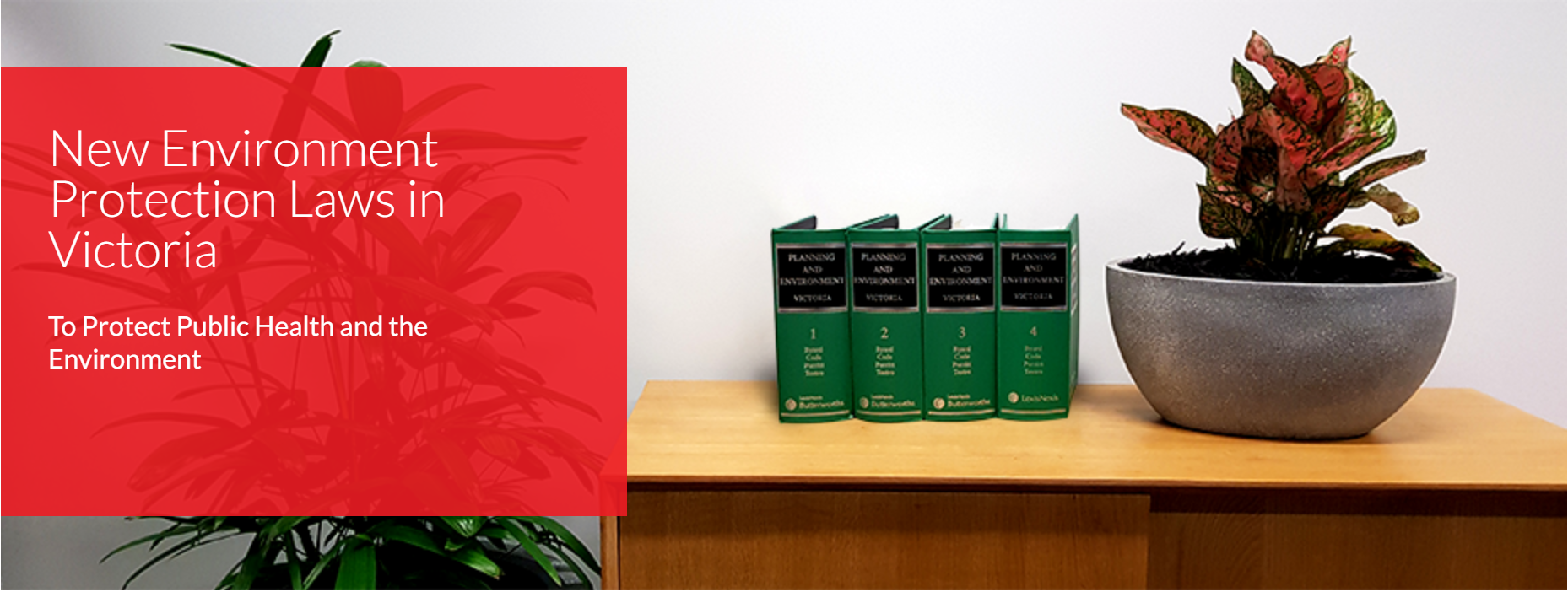
- Environment Protection Act 2017, annotated with commentary
- Environment Protection Regulations 2021
- Further commentary on environmental laws in Victoria
- Environment Reference Standard
- Other important practice materials, including those published by the Environment Protection Authority (EPA) Victoria
VCAT Senior Member, Ian Potts, in coordination with the Planning and Environment Victoria author team (Russell Byard, Geoffrey Code and Bill Sibonis), has provided expert analysis on how these new laws will operate in practice.
The new environment protection laws are relevant to all businesses and individuals in Victoria. It is recommended for these laws to be well understood by all Victorian business and industry operators, owners and managers, consultants and lawyers practising in property, planning and environmental law. The commentary provided will also be of high value to local and state government departments administering the new legislation or managing land use activities and the use and development of natural resources.
Further information
The new laws, detailed commentary and important resources will be available for Planning and Environment Victoria online (Lexis Advance and Lexis Red) subscribers in early July 2021. Customers with a hardcopy subscription will receive these updates in Service 238 in August 2021.
For more information about Planning and Environment Victoria, please contact the publication’s Legal Editor, Marcus Frajman. For enquiries about subscribing to the publication, please email sales.enquiries@lexisnexis.com.au or call +61 2 9422 2174.
Practice Area Updates
Franchising Law and Practice
An update to the Franchsing Code of Conduct. The Code was amended by the Competition and Consumer (Industry Codes—Franchising) Amendment (Fairness in Franchising) Regulations 2021
FEDERAL
Commentary in Franchising Law and Practice will be updated to reflect the changes to the Code and how they affect franchisors and franchisees. These changes come in response to the Fairness in Franchising report. The federal Government's consultation process ended on 4 December 2020 and the changes have a start date of 1 July 2021. The changes seek to offer greater protections to franchisees by providing them with a higher level of information, a reworked ADR process, a longer cooling-off period, increased penalties for non-compliant franchisors and a ban on retrospective variation without franchisee agreement. Consequently, the obligations of franchisors and franchisees have changed under the Code and Stephen Giles's updates to Franchising Law and Practice will help pracitioners working with franchisors and franchisees to understand how best to comply with and make use of their new duties and rights.
Competition and Consumer Act Annotated; Competition and Consumer Law News and Practice and Procedure High Court Federal Court
The Full Federal Court Decision of ACCC v Quantum Housing Group [2021] FCAFC 40
FEDERAL
The Quantum Appeal is significant because it provides clarity around the necessary and sufficient conditions of 'unconscionable conduct' as it appears in s 21. In short, the decision rejected the idea that unconscionable conduct required the element of exploitation of a vulnerability or disadvantage. This legal development has been carried through to 3 publications: there is an article by Owen Fischbein entitled 'The Quantum Litigation' which gave an informative and succinct summary of the case in Competition and Consumer Law News issue released in May 2021. Commentary on the case has also already been included in Competition and Consumer Act Annotated under clauses 20, 21 and 29. These updates have also been carried through to Practice and Procedure High Court & Federal Court. Our customers have quick access to the clarification of the requirements of unconscionable conduct - one of the most common issues raised in C&C law
Australian Property Law Bulletin; Australian Tax Law Bulletin
SPIC Pacific Hydro Pty Ltd v Commissioner of State Revenue [2021] NSWSC 395
FEDERAL, NSW
The recent judgment of the Supreme Court of New South Wales in SPIC Pacific Hydro Pty Ltd v Chief Commissioner of State Revenue [2021] NSWSC 3951 provides important guiding principles in the classification of fixtures (and in particular tenant’s fixtures) and valuation of land interests in the context of renewable energy projects. With the continued shift towards such projects in Australia, this case demonstrates the potentially hefty stamp duty implications in acquiring and disposing of interests in renewable projects. It also has relevance to the identification and valuation of fixtures for the purpose of the income tax regime involving “taxable Australian real property”. This case has been comprehensively discussed in Australian Tax Law Bulletin and Australian Property Law Bulletin in relation to the taxation and property aspects of the decision respectively. From this content, customers can gain an appreciation of the interdisciplinary application of this case and its legal implications.
Privacy Law Bulletin
The Australian Government is currently undertaking a review of the Privacy Act 1988 (Cth) and the AG's released the Privacy Act Review: Issues Paper
FEDERAL
Volume 18 No.2 of the Privacy Law Bulletin is a special issue in which members of the expert editorial panel have contributed articles discussing different aspects of the proposed changes to the Privacy Act including: the scope of the employee records exemption; possible impacts on the Notifiable Data Breaches Scheme; whether a direct right of action enabling individuals to pursue breaches of privacy principles directly in court should be created; the desirability and feasibility of an independent certification scheme with an underlying “standard” or framework against which to demonstrate compliance with Australian privacy laws; and a discussion as to whether the whole frame of reference for handling of personal information about individuals by APP entities should be reset. This special issue will enable customers to be across many of the major points of debate in relation to the Privacy Act review.
Personal Injury Litigation NSW
The commencement of the Personal Injury Commission NSW
NSW
The commencement of the Personal Injury Commission brought several changes to dispute resolution within NSW. This has impacted motor accident and workers compensation claims. Personal Injury Litigation NSW has been updated to include commentary on the Personal Injury Commission. Legislation has also been added within the publication, which includes; the Personal Injury Commission Act 2020, the Personal Injury Commission Regulation 2020 and the Personal Injury Commission Rules 2021.
ASX Listing Rules Australian Corporation Law Principles and Practice
ASX public consultation in late 2020 primarily to facilitate the introduction and operation of the next round of the new and updated online forms ASX is introducting in 2021. Additional non-related updating of security issues and corporate action timetables in Chapters 2, 3 and 19 and GN 8, 14, 20 and 30. These amendments were authorized by ASIC to commence on 5 July 2021.
ALL JURISDICTIONS
The ASX Listing Rules in all formats were updated to match the authorised changes. Australian Corporation Law Principles and Practice also re-produces the Rules, Appendices and Guidance Notes and these are also being updated.
Bourke's Criminal Law Victoria
In April 2021 judge alone trials were discontinued in Victoria (they were temporarily allowed up until that time from 25 April 2020 as a COVID-19 measure).
VICTORIA
In early June 2021 a special issue of Bourke’s Criminal Law News Victoria (included in a subscription to Bourke’s Criminal Law Victoria) was published – dealing with “COVID-19 and judge alone criminal trials”, and written by Felicity Gerry QC et al. The issue explores issues surrounding judge alone trials in a Victorian context.
Workplace Law Fair Work
The Paid Parental Leave Rules 2010 were amended by the Paid Parental Leave Rules 2021. For public sector employees, all parents will potentially have up to 14 weeks paid parental leave regardless of gender. The income cap for Paid Parental Leave has also been increased and new flexibility measures have been introduced for the manner in which leave is taken.
FEDERAL
The legislation has been inserted into Workplace Law - Fair Work, with commentary in the works from Ben Dudley, partner at Seyfarth Shaw.
Australian Family Law
On 1 September 2021, the Family Court and the Federal Circuit Court will be merged to become the Federal Circuit Court and Family Court of Australia
FEDERAL
In response to the merger of the Family and Federal Circuit Courts scheduled for 1 September 2021, the following updates will be made to Australian Family Law to keep customers abreast of changes to legislation, rules and court procedures: Repealed legislation moved to a transfer binder, new Federal Circuit and Family Court of Australia Act 2021 Act published with annotations, amendments to Family Law Act published with annotations, new harmonised court rules published with annotations, comparative table of rules between old rules and new rules, new court forms and practice directions.
Australian Health Law Bulletin
The decision Re CR recently handed down by the England and Wales Court of Protection: [2021] EWCOP 19 (12 March 2021).
Federal, State and Territory
Our general editor commissioned this case note as a matter of relevance because it is a key case on the law around consent to administer a COVID-19 vaccine to a person lacking legal capacity. Further, the administration of the vaccine was opposed by the patient’s relatives. We published the case note by a senior health law expert Alon Januszewicz titled "Authority granted in the UK to administer the COVID-19 vaccine to persons without legal capacity despite objections by relatives" in the April 2021 HLB, weeks after the case was released.
The relevance to the Australian readership:
This was in fact the third such English decision assessing whether administration of a COVID-19 vaccination (here, Astra Zeneca) was in the “best interests” of this patient. So far, there are no Australian cases on point here and the article helpfully provides the relevant Australian frameworks and principles by which such decisions may be made here. Importantly, the decision also had to weigh up competing concerns and opposition by the patient’s relatives. Such cases are bound to be brought to Australian courts and tribunals soon and this article is extremely helpful guidance for practitioners.
Did you like this page?
Contact Us Form
|
Webinars & Training |
Subscribe |
Rule of Law |
| Follow LexisNexis | |||
|---|---|---|---|

|

|

|

|
LexisNexis, Lexis Advance, CaseBase, Lexis Red, Halsbury’s, Lexis Legal Analytics and the Knowledge Burst logo are registered trademarks and Capital Monitor is a trademark of RELX Inc.
©2021 Reed International Books. Australia Pty Ltd trading as LexisNexis. All rights reserved.
 LexisNexis
LexisNexis

